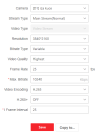Hi,
I have a little problem with my setup:
5 x DS-2CD2T87G2-L (V5.7.3 build 220112) conected to DS-7608NI-K1 / 8P (V4.71.000 build 220224)
When all cameras are set to H265+, two cameras start to lose main stream on recording, only grey screen is recorded other three records normally.
When two problematic cameras are set to H265, and other three remain on H265+ everything records ok. But when I playback video from H265+ cameras sometimes I get frozen frames from car or people in video...
Video setting for main stream 3840x2160, bitrate variable, highest quality, 25fps, max. bitrate 8192Kbps, video encodin H265 (3 with plus on, 2 with plus off)
Video setting for substream on all cameras 640x480, vaiable, medium, 25fps, max. 1024Kbps, H264
WDR on all cameras is always on.
Recording on all cameras is motion triggered - works ok.
Accusense intrusion event is set directly on each camera thru virtual host - works ok, alerts are sent on Hikconnect normaly
My question is are these problems with H265+ corupted stream and frozen frames, normal, or it could be solved with new I-class NVR
Thanks
I have a little problem with my setup:
5 x DS-2CD2T87G2-L (V5.7.3 build 220112) conected to DS-7608NI-K1 / 8P (V4.71.000 build 220224)
When all cameras are set to H265+, two cameras start to lose main stream on recording, only grey screen is recorded other three records normally.
When two problematic cameras are set to H265, and other three remain on H265+ everything records ok. But when I playback video from H265+ cameras sometimes I get frozen frames from car or people in video...
Video setting for main stream 3840x2160, bitrate variable, highest quality, 25fps, max. bitrate 8192Kbps, video encodin H265 (3 with plus on, 2 with plus off)
Video setting for substream on all cameras 640x480, vaiable, medium, 25fps, max. 1024Kbps, H264
WDR on all cameras is always on.
Recording on all cameras is motion triggered - works ok.
Accusense intrusion event is set directly on each camera thru virtual host - works ok, alerts are sent on Hikconnect normaly
My question is are these problems with H265+ corupted stream and frozen frames, normal, or it could be solved with new I-class NVR
Thanks



